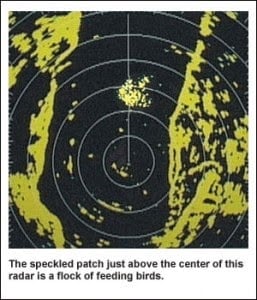 Understanding Your Radar
Understanding Your Radar
It’s no great secret that if you want to catch fish you need to know how to find them. One of the quickest ways of finding fish is to locate the birds - the undeniable masterminds of fish finding technology. What is a closely guarded secret is how to go about targeting these birds by using your Radar, a tool normally reserved for collision avoidance. Let's remove some of the mystery surrounding the subject.
At first sight, a radar picture seems to just be a mass of blobs. The general shapes of coastlines are usually easy to pick out, but some of the details, along with ships, boats, and buoys are harder to identify. To understand what the radar is seeing, we need to recognize that the radar picture isn’t a map; it’s a diagram showing the range and bearing of echoes. Radar works just like an echo sounder it transmits short pulses of energy and listens for the echoes produced when the pulses are reflected from something in their path.
Of course, there are significant differences between a radar and echo sounder:
- One is that radar sweeps its beam of pulses around the horizon like the beam of a lighthouse, instead of sending them all downwards.
- Another is that it uses super high frequency radio waves – microwaves – rather than sound waves. Your radars beam width is going to play a big part in its ability to effectively track feeding birds.
Remember: the narrower the beam width, the greater target discrimination you will have. As the length of the antenna radiator increases the beam width becomes narrower, so a larger antenna will invariably offer better target identification. For this reason, dome antennas are not as proficient at tracking birds as a comparable open array antenna. There is simply no replacement for experience and practice when it comes to becoming a skilled radar operator; however, to get there you need to start with the basics. For the best results it is best to practice these techniques on a clear day with calm seas. It is easiest to first visually locate a flock of birds that you want to target.
Targeting Birds
To begin targeting the birds:
- Set your Radar to a mid or long-range.
- Next, increase the Gain control until you see noise on the display. This will appear as a blanket of small specks. You will need to leave the Gain turned all the way up, thus setting the receiver for maximum sensitivity in order to detect birds. (Resist the temptation to turn up the AC/Sea or AC/Rain to drop out the noise. Flocks of birds may look like dense, recurring noise rather than a solid target, but you should be able to see them clearly.)
- This is what you will be looking for when you don’t have a visual cue as to where the birds are feeding:

If your Radar is capable of operating in True Motion, select this setting. You will be stabilizing the display, and be able to tell if the flock is traveling in a straight line looking for bait pods or if they have found their target school and are feeding. When operating in Head Up or True Motion, be sure to turn on your target trail function and set it for long trails to help track traveling flocks. Practice these techniques and soon you will be scouting your fishing spots just like the pros!




Let Us Know What You Thought about this Post.
Put your Comment Below.